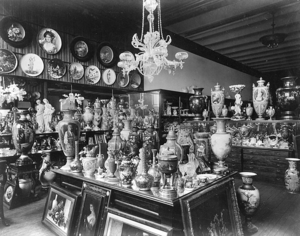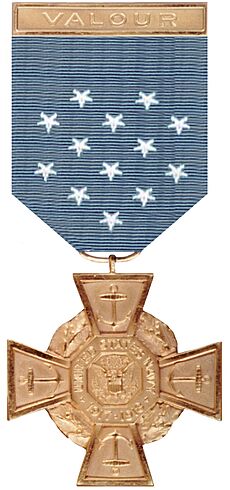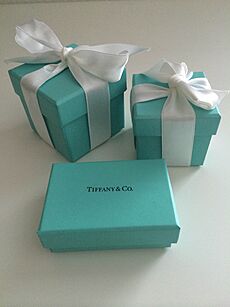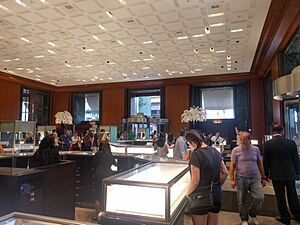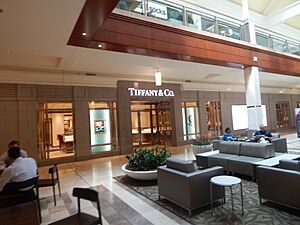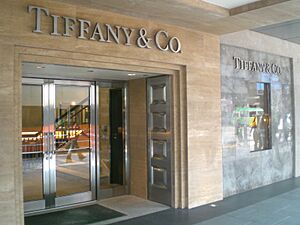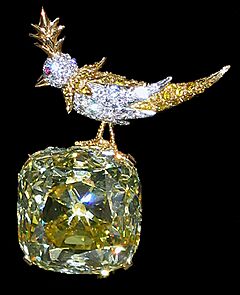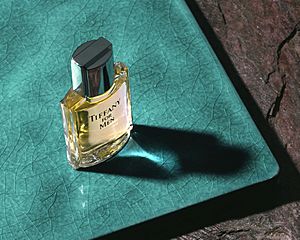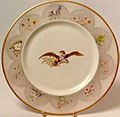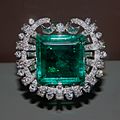- This page was last modified on 20 October 2025, at 01:33. Suggest an edit.
Tiffany & Co. facts for kids
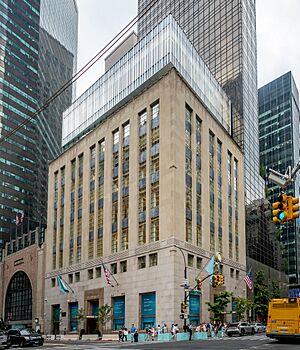
Tiffany's flagship store on Fifth Avenue in 2024
|
|
|
Formerly
|
Tiffany, Young and Ellis (1837–1853) |
|---|---|
| Subsidiary | |
| Traded as | NYSE: TIF (1987–2021)
S&P 100 component (until 2021) S&P 500 component (until 2021) |
| Industry | Retail |
| Founded | September 18, 1837 in Brooklyn, Connecticut, U.S. |
| Founders |
|
| Headquarters | 200 Fifth Avenue New York City, U.S. |
|
Number of locations
|
326 stores (2020) |
|
Area served
|
Worldwide |
|
Key people
|
|
| Products |
|
| Revenue | |
|
Operating income
|
|
| Total assets | |
| Total equity | |
|
Number of employees
|
14,100 (2020) |
| Parent | LVMH (2021–present) |
Tiffany & Co. (also known as Tiffany's) is a famous American company that sells luxury jewelry and other special items. Its main store is on Fifth Avenue in Manhattan, New York City. Tiffany is well-known for its beautiful sterling silver and diamond jewelry. You can buy these items in Tiffany stores, online, and through other businesses. The company also licenses its name for perfumes and eyewear.
Tiffany & Co. was started in 1837 by a jeweler named Charles Lewis Tiffany. It became very famous in the early 1900s under the artistic leadership of his son, Louis Comfort Tiffany. As of 2023, Tiffany had over 300 stores around the world. These stores are in many countries, including the United States, Japan, Canada, Europe, Latin America, and Asia-Pacific. The company sells fine jewelry, sterling silver, watches, porcelain, crystal, stationery, perfumes, and leather goods.
In January 2021, a large French company called LVMH Moët Hennessy Louis Vuitton bought most of Tiffany & Co. for about $15.8 billion. Tiffany's stock was then removed from the New York Stock Exchange. The company's main office is still in New York City.
Contents
History of Tiffany & Co.
Starting the Business
Tiffany & Co. began in 1837 in New York City. It was founded by Charles Lewis Tiffany and John B. Young. They started it as a "stationery and fancy goods emporium," which means a store selling paper goods and other interesting items. Charles Tiffany's father helped by giving them $1,000 from his cotton mill.
The store first sold many different stationery items. In 1837, it was called "Tiffany, Young and Ellis" and was located at 259 Broadway in Lower Manhattan. In 1853, Charles Tiffany took full control and changed the name to Tiffany & Company. He decided the company would focus mainly on jewelry. Since then, Tiffany has opened stores in major cities worldwide.
Unlike other stores in the 1830s, Tiffany clearly showed the prices on its goods. This meant customers did not have to haggle or bargain over prices. Also, Tiffany only accepted cash payments and did not allow people to buy things on credit. These ways of doing business were quite new for the time.
The "Blue Book" and the Civil War Era
The first Tiffany mail order catalog was called the "Blue Book." It was published in 1845 in the United States. Tiffany still publishes this catalog today.
During the American Civil War in 1862, Tiffany helped the Union Army. They supplied swords, flags, and tools for surgery. In 1867, Tiffany was the first U.S. company to win an award for its excellent silverware at a big exhibition in Paris called the Exposition Universelle. In 1868, Tiffany became an official company.
The "Gilded Age" of Growth
In 1870, Tiffany built a new store at 15 Union Square West in Manhattan. The building cost $500,000 and was designed by John Kellum. The New York Times newspaper called it a "palace of jewels." Tiffany stayed at this location until 1906.
In 1877, Tiffany created an insignia for a police medal of honor. This design later became the famous "NY" logo for the New York Yankees baseball team, which they adopted in 1909. In 1878, Tiffany won a gold medal for its jewelry and a grand prize for its silverware at another Paris exhibition.
In 1879, Tiffany bought one of the world's largest yellow diamonds. This diamond became known as the Tiffany Diamond. Only a few people have ever worn this diamond, including actress Audrey Hepburn when she promoted the movie Breakfast at Tiffany's. In 1887, Tiffany bought many pieces from an auction of the French Crown Jewels. This event brought a lot of attention to Tiffany and made its brand even more famous for high-quality diamonds. The company also helped redesign the Great Seal of the United States in 1885.
Tiffany in the 20th Century
After Charles Lewis Tiffany passed away in 1902, his son, Louis Comfort Tiffany, became the company's first official design director. Louis Comfort Tiffany was famous for his work with stained glass. He also made important contributions to Art Nouveau jewelry. He used new techniques with colorful glass, opals, and enamel. His designs often featured natural shapes and bright colors, making pieces that shimmered with light.
In 1905, the main Tiffany store in Manhattan moved to 37th Street and Fifth Avenue. It stayed there for 35 years.
In 1919, Tiffany revised the Medal of Honor for the United States Department of the Navy. This special "Tiffany Cross" was rare because it was only given for bravery in combat. Later, in 1942, the Navy stopped using the Tiffany Cross design.
The company moved its main store to its current location at 727 Fifth Avenue in 1940. This building was designed by Cross & Cross. In 1956, the famous designer Jean Schlumberger joined Tiffany. His designs, like the "Bird on a Rock" brooch, became very popular. Artist Andy Warhol also worked with Tiffany to create holiday cards between 1956 and 1962. In 1968, Lady Bird Johnson, who was the First Lady of the U.S., asked Tiffany to design a White House china set with 90 different flowers.
In 1978, Tiffany & Co. was sold to Avon Products, Inc. However, in the mid-1980s, some people felt that Tiffany's quality and service were not as good as before. In 1984, Avon sold Tiffany to a group of investors. Tiffany became a public company again in 1987.
During a difficult economic time in the early 1990s, Tiffany started to focus on selling to more people. They launched a campaign to show that Tiffany items could be affordable for everyone. For example, they advertised diamond engagement rings starting at $850. They also sent out brochures called "How to Buy a Diamond" to many people. However, Tiffany still kept its image as a luxury company by displaying high-style items in its stores.
In 1998, Tiffany & Co. officially registered its special Tiffany Blue color as a trademark. Three years later, they worked with Pantone to make sure the color was always the same, calling it "1837 Blue."
Tiffany in the 2000s and 2010s
The Tiffany & Co. Foundation was started in 2000. It gives money to groups that work to protect the environment and support the arts. In 2002, Tiffany & Co. created a company called Laurelton Diamonds. This company helps Tiffany manage its diamond supply around the world.
In 2009, Tiffany & Co. worked with a Japanese mobile phone company called SoftBank. They designed a special cell phone that had more than 400 diamonds, weighing over 20 carats. Only ten of these phones were made, and each one cost more than 100 million yen (about $672,687). Also in 2009, the company launched its "Tiffany Keys" jewelry collection.
In 2014, Tiffany introduced the "Tiffany T" collection, designed by Francesca Amfitheatrof. In 2017, the company launched its "Tiffany HardWear" collection.
In November 2017, Tiffany & Co. opened the "Blue Box Cafe" in New York City. This cafe lets customers experience dining inside a Tiffany store. They also launched their "Home & Accessories" line that same month.
In 2018, Tiffany opened a new 17,000-square-foot workshop for jewelry design and innovation. In May 2018, Tiffany launched its "Paper Flowers Collection," designed by Reed Krakoff. This collection also debuted in Asia in September 2018. That same month, the company introduced a new engagement ring design called the "Tiffany True."
In August 2019, Tiffany launched its first jewelry collection for men. In October 2019, Tiffany opened a new brand exhibition in Shanghai, China, called "Vision & Virtuosity." Tiffany opened its first store in New Delhi, India, on February 3, 2020.
Acquisition by LVMH
In November 2019, LVMH announced it would buy Tiffany & Co. for $16.2 billion. However, in September 2020, LVMH tried to cancel the purchase. Tiffany then filed a lawsuit. The companies later agreed in October 2020 that LVMH would buy Tiffany for a slightly lower price of about $15.8 billion. Tiffany's shareholders approved the deal in December 2020. When the deal was completed in January 2021, Tiffany's stock was removed from the New York Stock Exchange. After LVMH bought Tiffany, some of Tiffany's top leaders were replaced with executives from other LVMH companies.
Tiffany Stores Around the World
Since 1940, Tiffany's main store, known as its flagship store, has been located at the corner of Fifth Avenue and 57th Street in Manhattan, New York City. The outside of the store is made of polished granite and is famous for its window displays. This store has been featured in movies like Breakfast at Tiffany's and Sweet Home Alabama. Starting in 2019, the store went through a big renovation and reopened to the public on April 27, 2023.
The old Tiffany and Company Building on 37th Street is listed on the U.S. National Register of Historic Places.
When it opened in 1990, the Tiffany & Co. store at Fairfax Square in Tysons Corner, Virginia, became the largest Tiffany store outside of New York City. It has about 14,500 square feet of shopping space.
In France, Tiffany stores are located on Rue de la Paix and the Avenue des Champs Elysées in Paris. The Champs Elysées store is the largest Tiffany store in Europe.
In Australia, Tiffany's main store is on Collins Street in Melbourne, which opened in 1996. Tiffany has since opened eight more stores in Australia, including in Melbourne, Sydney, Brisbane, Perth, Adelaide, and the Gold Coast.
On March 8, 2001, Tiffany opened its first store in Latin America in São Paulo, Brazil. It was located in the Iguatemi São Paulo shopping center. The company opened a second store in the city in October 2003, near the famous Oscar Freire Street.
As of 2018, Tiffany had 93 stores in the U.S. and 321 stores worldwide. This included 55 locations in Japan and 85 in the Asia-Pacific region as of January 31, 2017.
In December 2023, Tiffany opened a store in Shanghai Taikoo Li Qiantan, China. In April 2024, Tiffany & Co. opened its newest store at QueensPlaza in Brisbane.
Advertising and Marketing
After the "Blue Book" catalog was first published in 1845, Tiffany continued to use it for advertising. The Tiffany catalog was one of the first to be printed in full color and was free until 1972. In 1994, Tiffany's mail-order catalogs reached 15 million people. Tiffany also creates a catalog each year for businesses. These businesses buy Tiffany products for gifts, employee awards, and customer rewards. While Tiffany still makes a catalog for subscribers, its advertising today uses many other methods.
Tiffany advertises in many places, including at bus stops, in magazines, newspapers, and online. With new technology, Tiffany placed ads in the New York Times' mobile app for the iPhone. Users could even download the Tiffany app from these ads. In January 2015, Tiffany launched its first advertising campaign featuring same-sex couples.
In 2017, Tiffany worked with American pop star Lady Gaga for an ad campaign promoting the company's "HardWear" collection. This announcement came with a Super Bowl ad before Lady Gaga's Super Bowl LI halftime show performance.
In May 2018, Tiffany partnered with Spotify for the launch of its "Believe in Dreams" campaign and "Paper Flowers" collection. They released a cover of the song "Moon River" by Elle Fanning and rapper A$AP Ferg on the music streaming service.
In 2019, Tiffany worked with American celebrity Kendall Jenner to promote the company's spring fashion line.
In 2021, Tiffany partnered with American singer Beyoncé and rapper Jay-Z for the company's "About Love" campaign. Beyoncé became the fourth woman, and the first Black woman, to wear the Tiffany Yellow Diamond. The campaign also featured Tiffany's recently acquired blue painting, Equals Pi (1982), by artist Jean-Michel Basquiat.
In 2022, Tiffany partnered with artist Curtis Kulig. He created love-themed messages like "Dare Me," "Know Me," and "Kiss Me" to go along with the Tiffany HardWear, Tiffany Knot, and Tiffany T collections.
In 2023, actress Anya Taylor-Joy became the face of Tiffany's fine jewelry campaign. She was featured in the 2023 Blue Book collection.
Tiffany Products
Diamonds
Tiffany is famous for its luxury items, especially its diamond and sterling silver jewelry.
George Frederick Kunz (1856–1932), a gem expert at Tiffany, helped make the metric carat a worldwide standard for weighing gems. The Tiffany Yellow Diamond (128.54 carats) is usually on display at the New York City flagship store.
In 1886, founder Charles Tiffany created the "Tiffany Setting" ring design. In this design, six prongs hold the diamond up from the band. This helps the diamond sparkle even more.
Colored Gemstones
Tiffany sells jewelry with many different colored gemstones. These include gems that Tiffany helped make popular, such as tsavorite, kunzite, and morganite. In February 2015, actress Cate Blanchett wore a turquoise and aquamarine necklace designed by Francesca Amfitheatrof, Tiffany's design director, at the 2015 Academy Awards. This colorful piece stood out from the white diamond jewelry worn by other stars.
Fragrances
In the late 1980s, Tiffany & Co. started making perfumes. "Tiffany" for women was launched in 1987. It was a floral perfume created by François Demachy. It was sold in major department stores across the U.S. Two years later, "Tiffany for Men" was launched in 1989. The bottles for both perfumes were designed by Pierre Dinand. In 1995, Tiffany launched "Trueste" perfume for women, but it was later stopped.
In October 2019, Tiffany launched a new perfume line called "Tiffany & Love."
Sports Awards by Tiffany
Tiffany & Co. creates many famous sports trophies.
- They make the Vince Lombardi Trophy for the winner of the NFL's Super Bowl.
- Since 1977, Tiffany & Co. has made the Larry O'Brien Championship Trophy for the winner of the NBA Finals.
- Tiffany makes and designed the World Baseball Classic Trophy and the Commissioner's Trophy each year for the winner of the World Series. Tiffany & Co. also made the 2010 and 2012 World Series rings for the San Francisco Giants.
- Since 1987, Tiffany silversmiths have crafted the US Open trophies for the United States Tennis Association.
- Tiffany & Co. makes the PGA Tour FedEx Cup Trophy each year since 2007.
- The MLS championship trophy was also made by Tiffany & Co.
- A £10,000 Rugby League World Cup trophy was made by Tiffany's to celebrate 100 years of Rugby league.
- In 2021, Tiffany & Co. became a sponsor for the LCK (a video game league). They give championship rings to the winners of the LCK finals.
- Since the 2022 League of Legends World Championship, Tiffany & Co. has been the official maker of the redesigned Summoner's Cup, which is given to the winner of the League of Legends World Championship.
- Since 2023, Tiffany & Co. has made the NBA Cup and Cup MVP trophies for the NBA's annual In-Season Tournament.
Helping the Community and Environment
Philanthropy and Conservation
In 2000, The Tiffany & Co. Foundation gave its first grant to help protect coral and marine life. So far, the foundation has given over $20 million to support coral and ocean conservation. In 2017, Tiffany launched its "Save the Wild Collection." This jewelry line helps raise money for endangered wildlife conservation. In 2018, Tiffany promised about $1.4 million to Australia to help protect the Great Barrier Reef.
Being a Responsible Company
Tiffany has bought gold that is mined ethically (in a fair and responsible way) since 1992. The company also follows the Kimberley certification process when they get their diamonds. This process helps prevent the sale of "conflict diamonds."
Tiffany stopped selling coral jewelry in 2004 because the health of the oceans was declining. In 2005, Tiffany joined Earthwork's "No Dirty Gold" campaign. They were the first jewelry company to follow Earthwork's "Golden Rules" for responsible mining.
In 2006, Tiffany & Co. joined with companies like Microsoft and others to create the Initiative for Responsible Mining Assurance (IRMA). In 2011, Tiffany joined the United Nations Global Compact. This initiative helps companies work towards global goals for sustainability and human rights.
In 2015, Anisa Costa became Tiffany's first Chief Sustainability Officer. That same year, Tiffany promised to have zero net greenhouse gas emissions by 2050. The company also supported the U.S. staying in the Paris Agreement on climate change.
Images for kids
-
White House china service for Lady Bird Johnson
-
Tea set, around 1877, at the Birmingham Museum of Art
-
Carved frog for display at the Exposition Universelle (1900) in Paris
-
Tray or Waiter, displayed at World's Columbian Exposition, 1893, Brooklyn Museum
See also
 In Spanish: Tiffany & Co. para niños
In Spanish: Tiffany & Co. para niños
- Art Nouveau glass art
- Clara Driscoll (Tiffany glass designer)
- John Loring (designer)
- Tiffany glass
- Tiffany lamp

